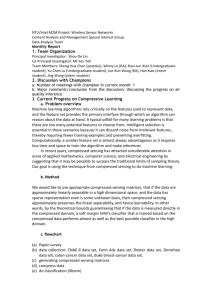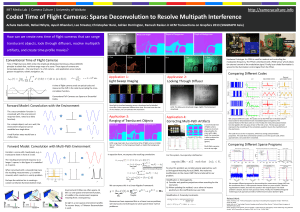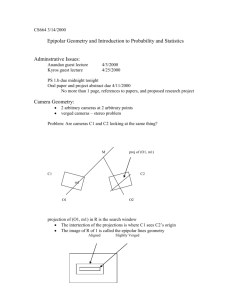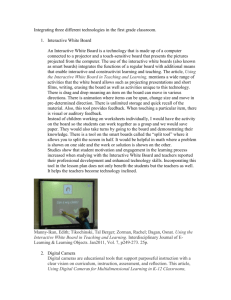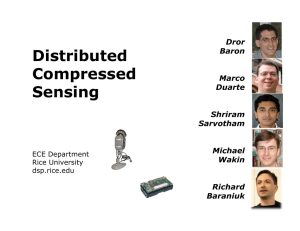EE225B Projects 2011..
advertisement
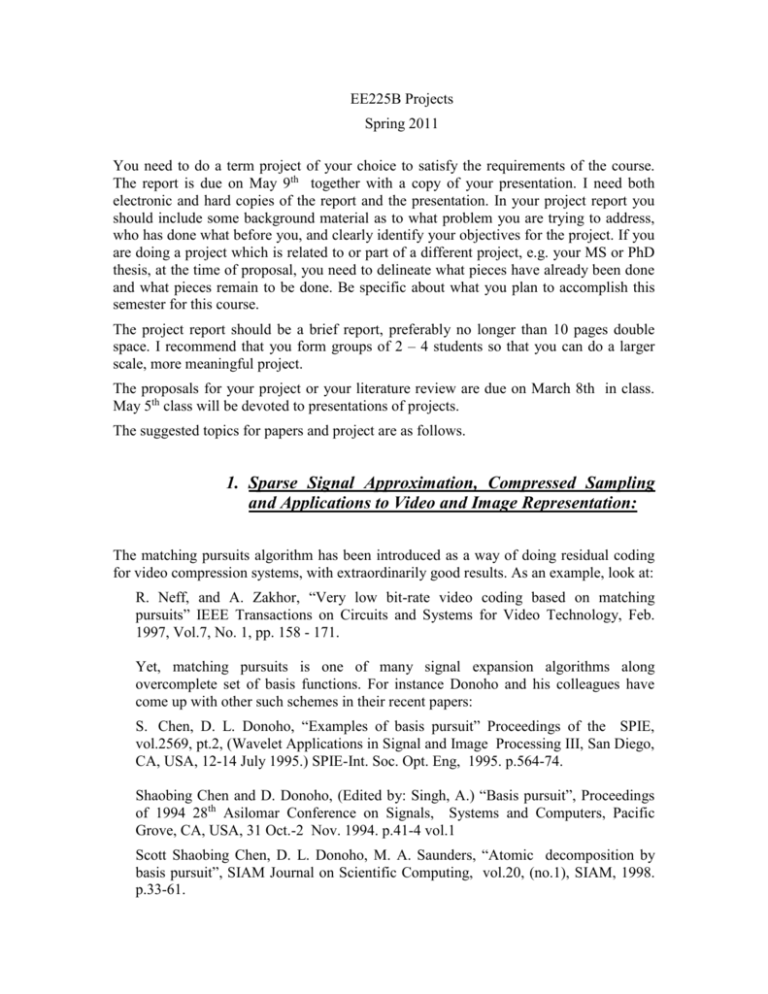
EE225B Projects Spring 2011 You need to do a term project of your choice to satisfy the requirements of the course. The report is due on May 9th together with a copy of your presentation. I need both electronic and hard copies of the report and the presentation. In your project report you should include some background material as to what problem you are trying to address, who has done what before you, and clearly identify your objectives for the project. If you are doing a project which is related to or part of a different project, e.g. your MS or PhD thesis, at the time of proposal, you need to delineate what pieces have already been done and what pieces remain to be done. Be specific about what you plan to accomplish this semester for this course. The project report should be a brief report, preferably no longer than 10 pages double space. I recommend that you form groups of 2 – 4 students so that you can do a larger scale, more meaningful project. The proposals for your project or your literature review are due on March 8th in class. May 5th class will be devoted to presentations of projects. The suggested topics for papers and project are as follows. 1. Sparse Signal Approximation, Compressed Sampling and Applications to Video and Image Representation: The matching pursuits algorithm has been introduced as a way of doing residual coding for video compression systems, with extraordinarily good results. As an example, look at: R. Neff, and A. Zakhor, “Very low bit-rate video coding based on matching pursuits” IEEE Transactions on Circuits and Systems for Video Technology, Feb. 1997, Vol.7, No. 1, pp. 158 - 171. Yet, matching pursuits is one of many signal expansion algorithms along overcomplete set of basis functions. For instance Donoho and his colleagues have come up with other such schemes in their recent papers: S. Chen, D. L. Donoho, “Examples of basis pursuit” Proceedings of the SPIE, vol.2569, pt.2, (Wavelet Applications in Signal and Image Processing III, San Diego, CA, USA, 12-14 July 1995.) SPIE-Int. Soc. Opt. Eng, 1995. p.564-74. Shaobing Chen and D. Donoho, (Edited by: Singh, A.) “Basis pursuit”, Proceedings of 1994 28th Asilomar Conference on Signals, Systems and Computers, Pacific Grove, CA, USA, 31 Oct.-2 Nov. 1994. p.41-4 vol.1 Scott Shaobing Chen, D. L. Donoho, M. A. Saunders, “Atomic decomposition by basis pursuit”, SIAM Journal on Scientific Computing, vol.20, (no.1), SIAM, 1998. p.33-61. http://www-stat.stanford.edu/~donoho/Reports/index.html Tipping, Rao and Delgado have also come up a new sparse representation called, Sparse Bayesian Learning (SBL). This technique requires applying large matrix inversions where the size of the matrix is N squared by N squared and an NxN image. Finally most recently Donoho, Candes and Baranuik have proposed compressed sampling as a way for sparse signal representation. In previous years, a group of students in EE225B implemented SBL, BP and MP and compared their performance over a set of images. However, the largest size images SBL could be run on was 32x32 due to storage limitations. In doing so, they showed that SBL outperformed the other two algorithms. For a class project, carry out a thorough literature search on compressed sensing and its potential application to image compression. Then try to answer some of these questions via doing simulations, experiments, analytical derivations, or literature search: Are compressed sensing methods currently proposed in the literature applicable to image coding/compression? Can they result in better performance than standards such as JPEG 2000? If so, how much improvement do they offer? You might want to run experiments on few images to demonstrate this. Can you devise your own “compressed sensing” method that beats JPEG 2000? Again, run it on a few images to demonstrate the performance of your proposed compressed sensing method. Are compressed sensing methods applicable to video compression? If so, how do they measure compared to standards such as H.264? 2. Video Similarity Search With the explosion of the amount of video data on the web, a number of techniques have been developed to detect nearly identical videos in a database. This is particularly useful when a content owner wants to know whether or not its video has been unlawfully distributed. Two examples of such papers include: Efficient video similarity measurement with video signature Cheung, S.-S. Zakhor, A. Dept. of Electr. Eng. & Comput. Sci., Univ. of California, Berkeley, CA, USA; Circuits and Systems for Video Technology, IEEE Transactions on; Publication Date: Jan 2003; Volume: 13, Issue: 1; On page(s): 59- 74 Fast similarity search and clustering of video sequences on the world-wide-web Cheung, S.-S. Zakhor, A. Univ. of California, Berkeley, CA, USA; Multimedia, IEEE Transactions on Publication Date: June 2005; Volume: 7, Issue: 3; On page(s): 524- 537 Possible projects are as follows: Propose ways to extend the above techniques to audio similarity search; Make sure your proposed technique is scalable. How would you extend the signature method to still images only? Address scalability and implementation issues. 3. Network of Cameras Sensor networks are becoming an increasing important area of research in recent years. One of the most critical issues in all sensor network technology is power. As such in monitoring applications where one is interested in detecting and tracking targets, low cost, low power sensors are usually used to wake up more sophisticated sensors such as cameras. Here are few projects in the area of network of cameras. An important issue in a network of camera problem is calibration of the cameras with respect to each other. The computer vision community has introduced several techniques for calibration, but all of them ignore the communication cost between the cameras. Implement a state of the art network of camera calibration scheme, and characterize its communication requirements. Propose ways of minimizing communication bandwidth during the calibration process. Design algorithms that would enable a network of cameras track an object, follow it and hand it off to the next camera for which the object is in the field of view. Consider this problem for both stationary cameras and those that are capable of panning, zooming and tilting. You might have to address camera calibration issues in the process. Propose ways to compress fields of views of multiple cameras that are looking at a common scene. Assume there is a lot of overlap between the cameras and that their respective images are highly correlated. Would you gain in compression if the relative poses of the cameras are communicated to each other ahead of time? What are the tradeoffs between upfront communication and compression efficiency?

